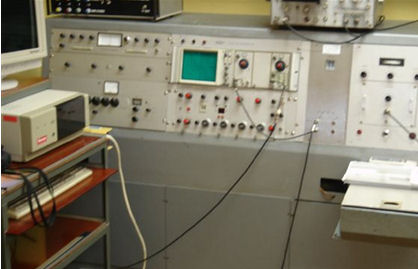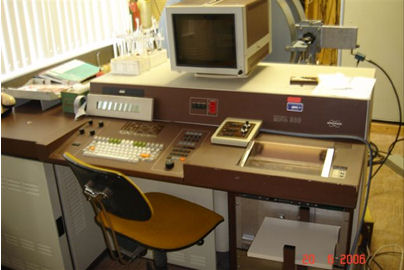Equipment at the Department of Nuclear Magnetic Resonance
SPINMASTER FFC2000 (the fast Field Cycling NMR relaxometer) is a unique NMR instrument designed to measure the field dependence of NMR spin-lattice and spin-spin relaxation time T1 and T2 (Nuclear Magnetic Relaxation Dispersion profiles) from 10 kHz to 40 MHz (1H Larmor frequency).
The system consist of the following units: 1 Tesla wide-bore electromagnet, double circuit magnet/power supply cooling system; 3 NMR probes working in different frequency range; variable temperature controller system for sample temperature control with 0.1 °C precision in the range of - 120 to + 140 °C; local magnetic field compensation system for low Field Relaxometry and Personal NMR Console with Software package: AcqNMR32.

The compact model of SPINMASTER FFC2000 with the electromagnet. The switching time between the polarization, relaxation and detection magnetic field can be 1 ms.
Bruker AVANCE spectrometer coupled to a vertical wide-bore (90-mm) magnet operating at 7.046 T (300 MHz for 1H). Special accessories like a gradient system, microimaging probehead, and the sophisticated imaging package allowed to performed the NMR imaging. The maximal gradient strength in x, y and z direction is 100 G/cm. The probehead for protons has four interchangeable coils of the diameter 5, 10, 15 and 25 mm. For small samples 1H imaging with 2D resolution of about 10 µm are obtained in our laboratory. The Para Vision software supports a variety of special processing functions including statistical analysis in regions of interest and 3D surface reconstruction. The following imaging methods are performed on our spectrometer:
- Gradient Echo Fast Imaging (GEFI)
- Multislice/Multiecho (MSME), T2 calculations
- Snapshot FLASH Method
- Contrast imaging
- Diffusion imaging (SEDIFFUSION, STEDIFFUSION)
- Constant time/ single point imaging (CTI/SPI)
- Localized spectroscopy (VOSY,VSEL)
- Chemical shift imaging (CSIND)

Bruker NMR pulse spectrometers (SXP 4-100 and MSL 300) with two electromagnets (2.2 T and 1.2 T) and superconducting magnet with a maximal field up to 8.4 T with set of NMR probe-heads for 1H, 2H 19F nuclei.
Two helium continuous flow cryostats (Oxford and Leybold) and one liquid nitrogen temperature controller (Bruker).




